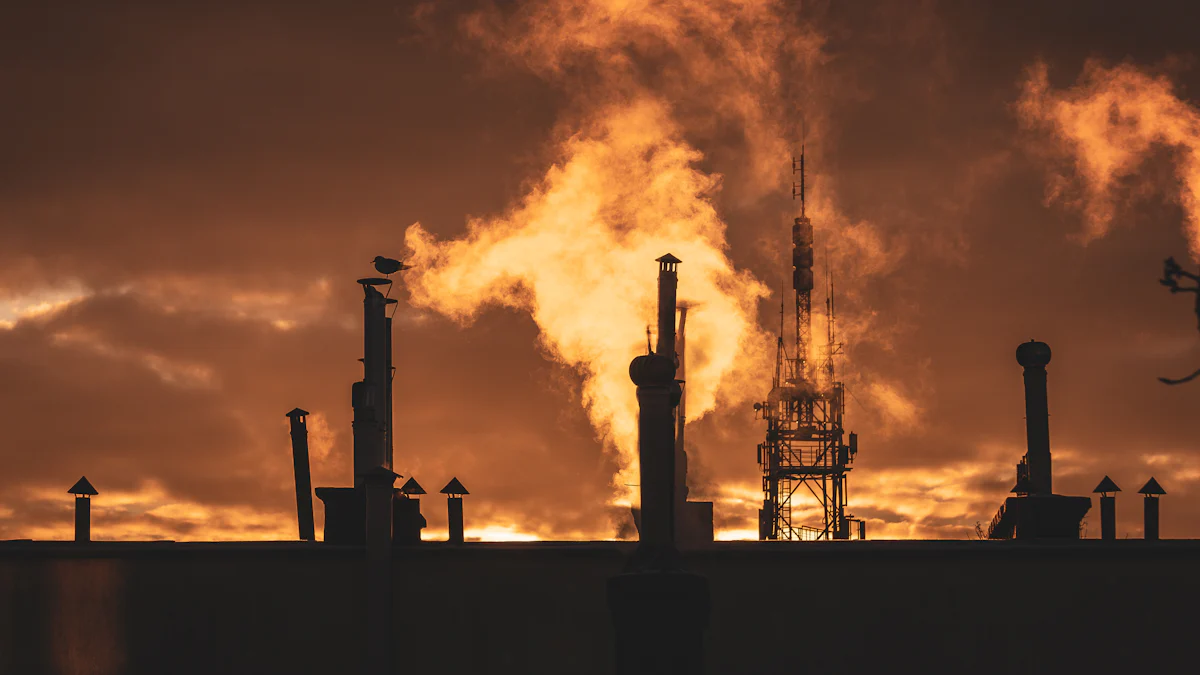
化学蒸気蒸着炭化ケイ素(CvD SiC)のコーティングは材料科学の進歩を表します。 これらのコーティングは、比類のない耐久性を提供し、要求の厳しいアプリケーションに最適です。 優れた耐熱性により、極端な温度下で確実に実行できます。 さらに、化学的安定性により、腐食性環境に対する長持ちする保護を保証します。 航空宇宙や電子機器などの高性能材料を必要とする産業は、これらの高度なコーティングから著しく恩恵を受ける。 ログイン シスコ コーティング技術は、さまざまな分野での効率性と信頼性を高めるソリューションを提供し、規格を改良し続けています.
要点
- ログイン SiCコーティングは、優れた耐久性と硬度を提供し、航空宇宙や製造などの業界での高強度用途に最適です.
- これらのコーティングは、1,000度を超える温度でも、構造的完全性と保護特性を維持し、極端な熱で信頼性の高い性能を保証します.
- 優秀な化学安定性によって、CvD SiCのコーティングは腐食および化学損傷から保護しま、粗い環境の重要な部品の寿命を拡張します.
- CvD プロセスはコーティングの特性上の精密な制御を可能にします、他のコーティングの技術と比較される優秀な均等性および付着を終らせます.
- CvD SiCコーティングの長持ち性能のおかげで、産業はメンテナンスと交換のニーズを削減することにより、大幅なコスト削減を実現します.
- ログイン SiCコーティングは摩耗およびエネルギー損失を最小にすることによって装置の効率を高めます、全体的な操作上の効果に貢献します.
- CvDの採用 SiCコーティングは、要求の厳しい材料要件を満たす高度なソリューションを提供することにより、さまざまな分野におけるイノベーションと進捗をサポートします.
CvD SiCコーティングとは何ですか?
CvDとSiCの定義
化学蒸気蒸着(CvD)とは何ですか?
化学蒸気蒸着(CvD)は、基質に薄膜やコーティングを作成するために使用されるプロセスです。 それは表面に固体材料を堆積する気体の前駆体の化学反応を含みます。 この技術は、コーティングの厚さ、組成、構造上の正確な制御を可能にします。 CvDは優秀な均等性および付着の良質のコーティングを作り出すために広く認められます。 航空宇宙、電子機器、製造などの産業は、CvDに頼りに材料の性能を高めています.
What is Silicon Carbide (SiC)?
シリコンカーバイド(SiC)は、シリコンと炭素原子で構成される化合物です。 それは例外的な硬度、熱伝導性および化学安定性のために知られています。 SiCは耐摩耗性、腐食性、高温性に優れ、要求用途に最適です。 そのユニークな特性は、耐久性と信頼性を必要とする産業でそれを好む材料をしました。 半導体から産業用ツールまで、SiCは、高度な技術と効率性の向上に重要な役割を果たしています.
どのようにCvD SiCコーティングが作られているか
CvDプロセスの概要
CvDプロセスは、ガス前駆体の反応室への導入から始まります。 これらのガスは高温で反応し、基質に堆積する固体材料を形成します。 プロセスは一貫性および質を保障するために制御された環境で起こります。 反応パラメータを調整することにより、メーカーは特定の要件を満たすコーティングのプロパティを調整することができます。 この柔軟性により、CvD SiC コーティングのような高度なコーティングを作成するために、CvD は不可欠です.
CvDの作成における重要なステップ SiCコーティング
- 基質の準備: : : 基質は不純物を取除き、適切な付着を保障するためにクリーニングを経ます.
- 前駆者の紹介: 炭化ケイ素およびカーボン化合物を反応室に導入.
- 化学反応: : : 高温は反応を促進し、炭化ケイ素の形成に導きます.
- 入金方法: : : SiC材料は基質に沈み、密で均一なコーティングを形作ります.
- 冷却および点検: : : コーティングされた基質は、質および性能を確かめる徹底した点検によって、冷却します.
この細心のプロセスは、CvD技術の恩恵をSiCの優れた特性と組み合わせるコーティングで結果をもたらします。CvD SiCコーティングは、材料の耐久性と機能性を高め、極端な条件で確実に実行することができます.
CvD SiCコーティングの主な利点

優れた耐久性と硬度
ログイン SiCコーティングは、長持ちする材料を要求する業界に好まれる選択をする驚くべき耐久性を提供します。 その密な結晶構造は、摩耗と摩耗を効果的に抵抗する例外的な硬度を提供します。 このプロパティは、CvD SiC でコーティングされたコンポーネントが重い機械的ストレスの下でも、その完全性を維持することを確認します。 交換とメンテナンスの頻度を減らすため、製造環境のツールや機器は、この機能から大幅に利益をもたらします。 CvD SiCコーティングの優れた硬度は、衝撃に耐える能力を高め、困難な条件で信頼性の高い性能を保証します.
高温抵抗
高温へのCvD SiCの展覧会の顕著な抵抗と塗られる材料。 この機能は、極端な熱が他のコーティングを劣化させる環境で確実に実行することができます。 ログイン シスコ 1000度を超える温度にさらされても、コーティングは構造的安定性と保護特性を維持します。 航空宇宙部品、工業炉、半導体製造装置に最適なソリューションです。 熱分解を防ぐことで、CvD SiCコーティングは材料の寿命を延ばし、熱集中的な適用の一貫した性能を保障します.
腐食および化学抵抗
ログイン SiCコーティングは腐食および化学損傷に対して優秀な保護を提供します。 その化学的安定性は、酸、アルカリ、酸化剤を含む積極的な物質との反応を防止します。 耐薬品性は、化学加工プラントや海洋用途など過酷な環境でもご使用いただけます。 コーティングは障壁として機能し、腐食性の要素からの基質を保護し、機能を維持します。 化学的摩耗のリスクを低減することにより、CvD SiCコーティングは、要求業界の重要なコンポーネントの信頼性と長寿を高めます.
極端な環境でのパフォーマンスの向上
ログイン SiCコーティングは、他の材料が頻繁に失敗する極端な環境で例外的な性能を発揮します。 そのユニークな特性は、過酷な条件に耐えることを可能にし、重要なアプリケーションにおける信頼性と効率性を保証します。 高温、腐食性の化学薬品および研摩の力は多くの材料に挑戦しますが、これらのシナリオのCvD SiCのコーティングのexcels.
高圧環境では、コーティングは構造の完全性を維持します。 その密な結晶構造は、激しい機械的ストレスの下でも変形や割れに抵抗します。 これにより、航空宇宙部品や産業機械の需要条件で動作する選択肢が優先されます.
コーティングはまた急速な温度の変動の環境で例外的によく行います。 熱衝撃は材料が拡大し、契約を、ひびか失敗に導く原因します。 ログイン シスコ コーティングは、優れた熱安定性を提供し、このリスクを最小限に抑えます。 半導体製造や高温反応器などの用途で一貫した性能を発揮します.
また、化学腐食に対するコーティングの抵抗は、化学加工や船舶工学などの産業における機能性を高めています。 攻撃的な物質からの損傷を防ぎ、重要な成分の寿命を延ばす保護障壁として機能します。 この耐久性は、メンテナンス要件と運用ダウンタイムを削減し、全体的な効率性を向上させます.
CvD SiC Coatingは、さまざまな業界におけるイノベーションと進歩をサポートしています。 過酷な環境に耐える能力は、耐久性とレジリエンスを必要とする用途に非常に貴重なソリューションです.
CvDの適用 SiCコーティング

航空宇宙・防衛
ログイン シスコ コーティングは、航空宇宙および防衛産業において重要な役割を果たしています。 タービンブレードやエンジン部品などの航空機部品は、極端な温度と機械的ストレスに耐えることができる材料を必要とします。 コーティングはこれらの部品の耐久性を高め、高速操作の間に信頼できる性能を保障します。 酸化および腐食への抵抗は環境損傷から重要な部品を保護し、寿命を延ばします.
防衛用途では、コーティングは高度な兵器および保護装置の性能を向上させます。 レーダー システムおよびミサイル コンポーネントは熱安定性および耐久性から寄与します。 CvD SiCコーティングは、メンテナンスニーズの低減と運用効率の向上により、これらの分野における最先端技術の開発をサポートしています.
半導体・エレクトロニクス
半導体およびエレクトロニクス業界は、CvD SiCコーティングに優れた特性を発揮します。 半導体製造では、高温プロセスにおける精度と信頼性を保証します。 ウェーハキャリアやエッチングチャンバーなどの装置を化学腐食や熱劣化から保護します。 半導体デバイスの品質を高め、生産ダウンタイムを削減します.
パワーモジュールやサーキットボードなどの電子部品は、コーティングの熱伝導性と電気絶縁の恩恵を受けています。 これらの特性は熱放散を改善し、過熱を防ぎま、電子機器の安定した性能を保障します。 過酷な環境に耐えるコーティングの能力は、高度な電子機器の生産に不可欠です.
産業・製造装置
CvD SiCコーティングを活用して、機械や工具の性能を向上 コーティングの硬度と耐摩耗性は、切削工具、金型、金型に最適です。 装置の寿命を増加させ、取り替えのコストを最小にする摩耗および破損を減らします.
腐食性の化学薬品か研摩材料を含む製造工程では、コーティングは保護障壁として機能します。 装置の表面への損傷を防ぎ、一貫した操作およびプロダクト質を保障します。 炉やリアクターなどの高温用途、コーティングの熱安定性にもメリットがあります。 産業用機器の耐久性と効率性の向上により、CvD SiCコーティングはコスト削減と運用信頼性に貢献します.
医学および科学用具
ログイン シスコ コーティングは、重要なツールや機器の性能と耐久性を高めることで、医療と科学分野に革命をもたらしました。 独自の特性により、精度、信頼性、過酷な条件に対する耐性を要求する環境に不可欠です.
医療機器はCvD SiCのコーティングから著しく寄与します。 この材料によって塗られる外科用具は例外的な硬度および耐久性を、保障します延長期間上の鋭さおよび機能性を維持します。 この耐久性は、コストを削減し、繊細な手順で一貫したパフォーマンスを保証します。 また、CvD SiCコーティングの化学的安定性は、滅菌剤との反応を防止し、繰り返し洗浄サイクル後にも医療工具の完全性を維持します.
科学的研究では、CvD SiCのコーティングは実験室装置の信頼性を改善します。 顕微鏡、分光器、その他精密機器は、腐食性物質への摩耗や曝露に耐えることができる材料を必要とします。 コーティングは保護障壁として機能し、これらの装置を損傷から保護し、正確さを維持します。 研究者は、装置の故障による中断のない実験を実施するために、この耐久性に依存しています.
科学的な設定の高温適用はまたCvD SiCのコーティングから寄与します。 材料試験や化学合成で使用される炉や原子炉は、極端な熱に耐えることができるコーティングを必要とします。 ログイン シスコ コーティングは熱安定性を提供し、これらの用具が要求する条件の下で効率的にそして安全に作動することを保障します.
CvD SiCコーティングの生体適合性は、医療用インプラントや装置の使用をさらに延長します。 ペースメーカー、専門性、その他のインプラント機器は、人体に悪影響を及ぼさない材料を必要とします。 ログイン シスコ コーティングは、拒絶または合併症の危険性を減らす安定した、不活性な表面を提供します。 このプロパティは、医療技術の進歩と患者の成果を改善するための貴重なソリューションです.
医療および科学用具の性能を高めることによって、CvD SiCコーティングはこれらの重要な分野の革新そして進歩を支えます。 摩耗、腐食および極端な条件に耐える能力は、専門家が正確で一貫した結果を提供するために、その装置に頼ることができることを保証します.
なぜCvD SiCコーティングが優れているのか
その他のコーティング技術の比較
ログイン SiCコーティング対PVD(物理蒸着)
化学蒸気蒸着(CvD)と物理蒸着(PVD)は、2つの異なるコーティング技術を表しています。 ログイン シスコ コーティングはPVDのコーティングと比較される優秀な均等性および付着を提供します。 CvDプロセスは、コーティングの厚さと組成を正確に制御し、表面全体にわたって一貫した品質を保証します。 一方、PVDは、特に複雑な幾何学上の均一性の同じレベルを達成することに苦労します.
ログイン シスコ 耐久性や耐摩耗性に優れ、極端な条件にも優れています。 密接な結晶構造は、優れた硬度と耐摩耗性を提供し、高い機械的ストレスを伴うアプリケーションに最適です。 いくつかのシナリオで効果的ながら、PVDコーティングは、通常、同じレベルの堅牢性を欠きます。 高温や腐食性化学物質への暴露など、過酷な環境下でもより早く劣化する可能性があります.
極端な熱に耐えるCvD SiCコーティングの能力は、それをオフに設定します。 PVDコーティングは適度な温度に耐えることができますが、それらは頻繁に延長された高い熱に露出したときに失敗します。 ログイン シスコ コーティングは、1,000度を超える温度でも、構造的完全性と保護特性を維持します。 航空宇宙や半導体製造などの業界に好まれる選択肢です.
CvD SiCコーティング対従来のコーティング
塗料や電気めっき層などの従来のコーティングは、CvD SiCコーティングの高度な特性に一致できません。 これらの慣習的な方法は頻繁に唯一の表面レベルの保護を、要求する条件の下ですぐに身に着けます。 ログイン シスコ コーティングは、対照的に、基質とシームレスに統合する化学結合層を形成します。 長持ちする性能と耐摩耗性を確保します.
従来のコーティングはまた化学安定性の面で不足します。 それらの多くは積極的な物質と反応し、腐食および分解に時間をかけて導きます。 ログイン SiCコーティングは、その例外的な耐薬品性で、酸、アルカリおよび他の腐食剤に対する障壁として機能します。 従来のコーティングが十分な保護を提供できない環境では、この特性は不可欠です.
さらに、CvD SiCコーティングは高温適用の従来のコーティングを出力します。 塗料および電気めっきされた層は頻繁に熱にさらされるとき効果を失います。 ログイン シスコ コーティングは保護品質を保持し、極端な環境で信頼性の高い性能を保証します。 熱応力を耐え、酸化に抵抗する能力は、高性能材料を必要とする業界に優れたソリューションです.
コスト効果と長期性能のメリット
ログイン シスコ 耐久性と長期性能により、コスト効率が大幅に向上します。 その例外的な硬度および耐久性は取り替えおよび修理の頻度を減らします。 メンテナンスコストを削減し、ダウンタイムを最小限に抑え、運用効率の向上に貢献します.
極端な条件に耐えるコーティングの能力はさらにその価値を高めます。 CvD SiCでコーティングされた材料は、過酷な環境での機能性を維持し、頻繁な交換の必要性を減らします。 この長寿は、初期投資をオフセットし、高性能なアプリケーションにコスト効果の高いソリューションを提供します.
ログイン シスコ コーティングはまた特定の適用のエネルギー効率を改善します。 その低い摩擦係数は機械システムで摩耗およびエネルギー損失を減らします。 このプロパティは、装置のパフォーマンスを向上させ、運用コストの節約につながります.
耐久性、信頼性、効率性を兼ね備えたCvD SiCコーティングは、比類のない長期的な利点を提供します。 先進材料に頼る産業は、イノベーションと進歩を支える優れたコーティング技術として価値を認識しています.
ログイン シスコ コーティングは、優れた耐久性、耐熱性、耐薬品性などの比類のない特性で際立っています。 これらの資質は極端な条件の材料の性能そして信頼性を高めることによって革命的な企業を持っています。 代替コーティング技術の優位性は、さまざまな用途に長期にわたる利点と費用効果が保証されます。 高度なソリューションを求める産業は、要求の厳しい要件を満たすために、このコーティングに依存することができます。 CvD SiCコーティングを採用することで、業務における効率性、耐久性、革新性を高めます.